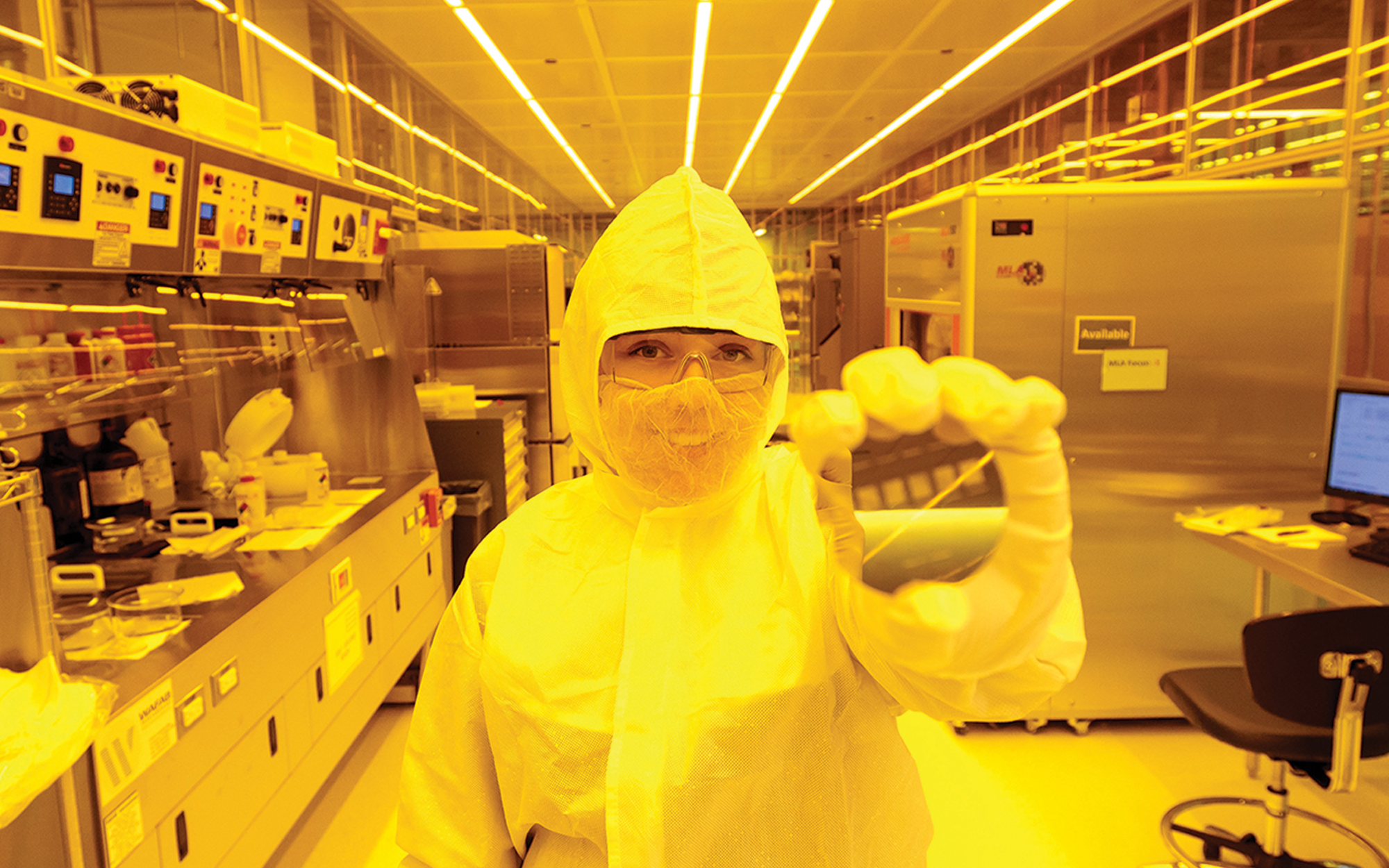
What’s she holding? See below for the answer. (Photography by John Zich)
Abigail Shearrow, AB’16 (physics and mathematics), works as a quantum engineer in the lab of David Schuster, assistant professor of physics.
What is that outfit called?
I work in the Pritzker Nanofabrication Facility for a physics group that is working toward making a quantum computer. I fabricate circuits that are really tiny, on the scale of microns. Having a clean environment gives the circuits you’re making a better chance of working. If you get dust on them, or fuzz, or little particles of dirt, it can contaminate your process. So we wear these suits—we call them bunny suits—to keep anything that’s on us inside the suit and not in the clean room.
Is it a pain to put on? And don’t you get hot?
There are two stages to getting gowned up. In the first stage, you have to put booties over your shoes and a hairnet on. You also put on a beard cover, which is like a hairnet for your face. We use them because if you get spit on what you’re making—if you cough or something—that can ruin it.
Then you move into the next room, and you have this white zip-up jumpsuit that you get into. It’s really fibrous, like normal clothing but papery, similar to the gowns you’d get in a doctor’s office. You have a hood that goes over the hairnet. You have a pair of boots that go up to your knees, and then you put gloves on and tuck the ends of your suit into the gloves. Sometimes, depending on what you’re doing, you have to wear two pairs of gloves. The temperature and the humidity inside the clean room are monitored in order to keep all the processes the same, and it tends to run a little cold, so no, you don’t feel hot.
When all your coworkers are wearing the same thing, how do you tell anyone apart?
Some people write their names on the back of their suits. Eventually, if you’re in there a lot, you get to know everyone, and you can recognize them by their height, or you can walk up and awkwardly try to see their face underneath their mask. It’s weird; it starts to feel like a normal work space. Someone will be like, “How was your weekend?”
What’s up with the yellow light?
The clean room is divided into bays, and in some bays the lights are yellow. That’s because when we build our circuits, we start by evaporating metal onto an entire wafer. To make the circuit itself, we pattern the wafer and remove some of the metal. To do that, we coat the wafer with a viscous liquid called resist, and then we bake it, and it forms a soft plastic. Then we pattern the resist using either lasers or an electron beam. The yellow light makes the resist last longer.
Isn’t it difficult to work with small things when you’re wearing gloves?
Yeah, the stuff in the circuits can be smaller than the wavelength of light, which is trippy to think about. You do lose dexterity, but you get used to it. I haven’t dropped anything. I know people who have, though, and sometimes it’s surprisingly OK. I know someone who dropped his circuit facedown on the ground, and he cleaned it off, and it still worked.
Have you ever had to leave for something while you were still gowned up?
Once I was in the middle of cleaning the evaporator in our lab, which deposits metal onto wafers. I didn’t have to be fully gowned up, but I did have to wear a hair net, a mask, and gloves. I had to run out to get someone, and I stepped on an elevator that was full of 10 people. They looked at me like, “Oh my God, what is that?” I was like, “This is the science building. This can’t be the weirdest thing you’ve seen.”
So, what is she holding? (See image above.) “An old sample that I helped to fabricate”: niobium on a sapphire wafer, Shearrow explained by email. This one wasn’t used because the circuit design was changed.
If the sample had been finished, “it would have been diced into 24 chips. Normally these circuits would be cooled down in the lab’s dilution refrigerators to 20 milliKelvin (past the temperature at which niobium goes superconducting) to be tested. For reference, outer space is about 2.7 Kelvin, so the fridges reach a temperature that is 100 times colder than outer space.”
Ordinarily Shearrow would use wafer tweezers, “so as not to contaminate the sample with anything that might be on my gloves. Since this sample won’t be used, it was all right to touch this one.”
